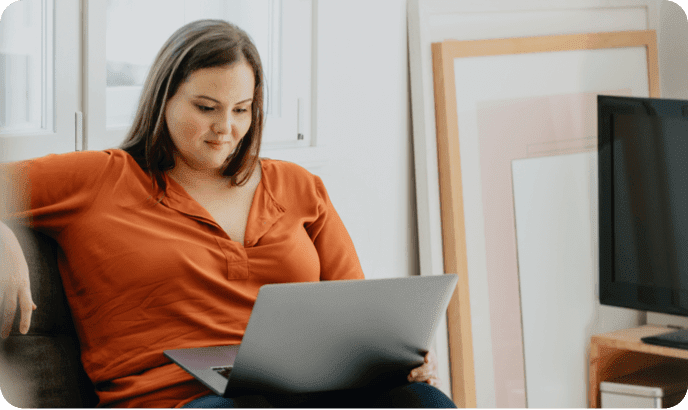Rate makes it quick & easy.
At reasonable rates with personalized terms.

Low rates
Easy fixed-rate monthly payment
.svg)
Fast application
Apply in as few as 10 min
.svg)
Quick turnaround
Funds in 1-2 business days
.svg)
Repayment options
From 1-5 years

Get the extra financial help you need.
Use your Rate personal loan to help:
- Consolidate high-interest rate debt
- Remodel your home
- Cover unexpected expenses like car repairs or medical bills
.jpg)
As easy as 1-2-3!
Get the extra financial help you need.

Check your rate
Select your loan amount, and see your loan options without impacting your credit score.
Check your rate
Select your loan amount, and see your loan options without impacting your credit score.
.svg)
Customize your loan
Choose from three repayment terms to find interest rate and monthly payment that fits your budget.
.svg)
Get your funds fast
Upon approval, sign your loan contract and then you’ll have your funds. It is that simple.
Personal loan FAQs
A personal loan is money borrowed from a lender at a fixed interest rate that is paid back by the borrower monthly over 1-5 years depending on the time frame and monthly payment option selected. Rate personal loans are unsecured, meaning they require no collateral.
Rate conducts a soft credit pull to check the rates and terms you qualify for, that will not affect your credit score. If you are offered loan options and proceed with the application, we will verify the accuracy of your application, which is considered a hard credit pull. This action will be recorded as an inquiry on your credit report and may impact your credit score.
Personal loans from Rate typically offer higher loan amounts and lower rates than a credit card, feature a fixed payment plan and require no collateral. You can use a personal loan for nearly any expense from remodeling a bathroom to debt consolidation to funding a family vacation.
Rate personal loans come with a fixed interest rate, and individual rates are determined based on your credit history, application information, the term you select, and other factors.
Standard fixed rates range from 9.99% to 21.99% APR. With a 0.25% autopay discount established at loan origination with an automated monthly debit from a qualifying deposit account for repayment, fixed rates range from 9.74% to 21.74% APR. Loan amounts range from $4,000 - $50,000 and are subject to state requirements. Loan proceeds cannot be used for post-secondary education expenses or to purchase cryptocurrency or securities. An origination fee of 0%-6% is charged for each loan, which will be deducted from any loan proceeds you receive, and are subject to state requirements.
Personal loans from Rate range from $4,000 to $50,000 in most states. The maximum amount you may borrow depends on your state of residency and what you qualify for based on your application information.
With Rate personal loans, you can apply in minutes, get a decision in under 60 seconds, and receive your funds 1-2 business days after approval.
If you have any questions regarding your personal loan application or need assistance, please feel free to reach out to our dedicated personal loans team at 833-533-2306 during our operating hours, which are Monday to Friday from 9 a.m. to 6 p.m. EST. Additionally, you can email us at [email protected].

Loans are made by Guaranteed Rate, Inc. (NMLS ID 2611).
Standard fixed rates from 9.99% to 21.99% APR. With a 0.25% autopay discount established at loan origination with an automated monthly debit from a qualifying deposit account for repayment, fixed rates range from 9.74% to 21.74% APR. Loan amounts range from $4,000 - $50,000 and are subject to state requirements. Loan proceeds cannot be used for post-secondary education expenses or to purchase cryptocurrency or securities.
Terms and Conditions: You must be 18 years of age or older (19 years of age or older in Alabama). To qualify, a borrower must be a US citizen, a permanent resident, or a non-permanent resident in the US on a valid, long-term visa. All loan applications are subject to credit review and approval as well as income and employment verification. You must meet our minimum requirements established for this offer including, but not limited to, credit history, debt-to-income ratio, and application information. Your actual rate depends on your requested loan amount, loan term, creditworthiness, and a variety of other factors. Loan amounts range from $4,000 - $50,000. Rates and loan amount may differ due to state-specific requirements and may impact your ability to qualify for a loan. Limitations: AK, AR, FL, KS, MA, NC, PA, RI, TX, IL, MA, NH, NM and WY (rate). The lowest rate advertised is reserved for the most creditworthy borrowers. Advertised rates and terms are current as of 02/21/25 and are subject to change without notice.
An origination fee of 0%-6.5% is charged for each loan, which will be deducted from any loan proceeds you receive, and are subject to state requirements. Restrictions apply, please refer to http://rate.com/personal-loans for more information.
Personal loans are only available in AK, AL, AR, AZ, DC, DE, FL, GA, IA, IL, KS, KY, MA, MD, MI, MO, MT, NC, NH, NJ, NM, OH, OK, PA, RI, SC, SD, TN, TX, UT, VT, WA, WY and as of 11/10/25. Loan applications outside of these states will not be accepted at this time.

